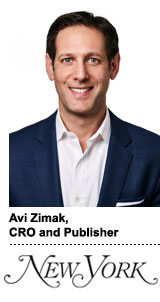
When New York Media charted its digital strategy, it chose not to go local.
Instead, the publisher of New York magazine created standalone blogging brands with national distribution around fashion (The Cut), culture (Vulture) and food (Grub Street). And it’s since added tech (Select All) and science (The Science Of Us) to the list of blogs.
New York Media’s blog-focused digital presence is what lured Avi Zimak to join the company as the publisher and CRO in March. The exec had logged time at Hearst, Time Inc. and Condé Nast before joining Outbrain in 2012 to boost sales.
“To be candid, I didn’t think I would come back to the world of traditional media,” Zimak said.
But New York Media’s blog portfolio appealed to him.
“When you look at the big publishers, 90% of the digital business they created is tethered to their traditional properties,” Zimak said. “That’s the way they go to market. To me that was an antiquated model.”
Instead of selling the digital version of New York Media, the publisher can offer advertisers products that are broader but still true to the brand.
“We have these [blogs] that live and breathe on their own, but fit into the DNA of our traditional publication,” Zimak said
Zimak joined Outbrain as it went from 100 to 600 staffers and bringing that startup ethos to New York Media. He wants it to run more nimbly and for staffers to infuse more data into their decision-making.
Zimak talked to AdExchanger about his first few months on the job.
AdExchanger: How is New York Media diversifying revenue beyond print or digital display?
AVI ZIMAK: Because of the way that we have structured our business, it’s safe to say the majority of revenue is digital already. We’ve been there for years.
When you look at our online properties, the majority of that distribution is national. Eighty-five percent of distribution is outside of New York region. Nearly the inverse is true with the magazine. Seventy percent of distribution is New York and 30% outside New York.
What were you brought in to do?
They were looking for someone to come in that has that startup and tech background to bring a different kind of thinking to the table. The business units are going to be more data-focused in their approach, which they have grabbed and run with pretty quickly.
And they want a different type of thinking in terms of what we can bring to the market: How do we leverage the data we’ve harnessed through our custom content studio? How do our 44 million readers tick? How will they engage with certain pieces of content on our sites?
How has your commerce play, The Strategist, worked out?
I’m wearing the best low-cut socks that don’t slip off your foot [recommended by The Strategist] right now. The Strategist is growing exponentially, and we are seeing significant revenue. We earn affiliate revenue and a few direct deals.
It’s eye-opening in a positive way, particularly as we hear that others are failing with commerce, like [Condé Nast’s] Style.com, which just shut its doors. We have a unique and specific voice in terms of how we are curating those recommendations, and our consumers trust it.
How is programmatic affecting your business?
Our focus is not on selling banners. It’s creating unique experiences and custom content for brands we partner with. Because we are selling such premium brands, it does limit the opportunity for programmatic. We are constantly exploring ways to create additional opportunities for all the various buckets of programmatic, whether it’s guaranteed programmatic or otherwise.
How much of an investment are you making in video?
On the editorial side, we have started to create a number of short-form video series with eight to 13 episodes on topics that are endemic to our general-interest mags. We have “Face Race,” “Best of New York” videos and Mark Bittman will be making weekly videos for us. TNT “Claws” sponsored an episode of “Face Race.”
On the content studio side, brands see video as an important part of their marketing strategy, and we want to make sure they are creating meaningful content that will work for them.
Do you have an industry pet peeve?
I think there is a lot of grasping for straws and forcing the dialogue that print is thriving. In reality, print is not thriving.
There are certain publications that are doing well – we see audience growth in the magazine of 16% year over year – but we smartly have one magazine.
I sometimes wonder who some of these publishers think they are kidding. Data is data, numbers are numbers. You have to be attuned to that and provide the real story to advertisers.
If print is in decline, what print-digital publishers have the best chances?
The strong will survive. The brands that continue to be meaningful to consumers will survive. I think publishers as a whole need to understand that results are what ultimately win.
The metrics for those results are going to continue to evolve, which means that publishers need to make sure they are providing marketing partners and advertisers with the results they are looking for in the way they are looking for.
Transparency is key. That’s why we have partners like Moat on the viewability front, and other third parties to ensure they are getting that transparency.
This interview has been condensed and edited.
This post was syndicated from Ad Exchanger.

More Stories
Best Buy and CNET Are Combining Their Ad Inventory
Buyers Are Wasting Money on Alt IDs While Cookies Still Persist
Ibotta Crosses The IPO Finish Line – Now The Real Work Begins